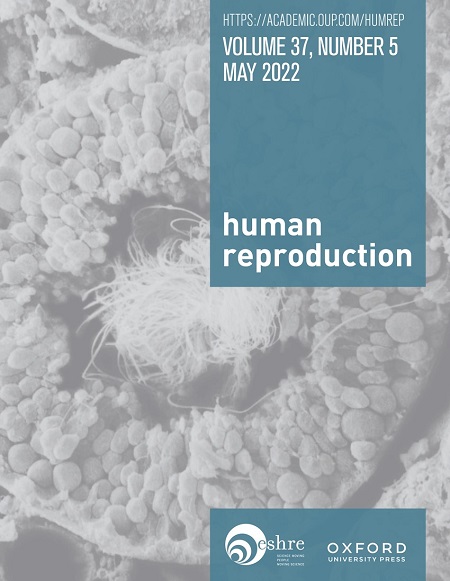使用手腕温度进行回顾性排卵日估计和下一次月经开始日预测的算法性能:一项前瞻性队列研究
IF 6
1区 医学
Q1 OBSTETRICS & GYNECOLOGY
引用次数: 0
摘要
研究问题:在兼容的iPhone和Apple Watch型号上,使用手腕温度的算法可以回顾性地估计排卵日期并预测下一次月经开始日期吗?使用手腕温度的算法可以为典型或非典型周期长度的个体提供回顾性排卵估计和下一次月经开始日预测。手腕皮肤温度受与月经周期相关的激素变化的影响,可以用来估计周期事件的时间。研究设计、规模、持续时间我们对262名14岁及以上的经期女性(899个月经周期)进行了一项前瞻性队列研究,她们记录了月经,进行了尿LH检测以确定排卵日期,记录了每日基础体温(BBT),并收集了夜间手腕温度。参与者的月经周期在2到13个之间。参与者/材料,设置,方法对三种算法的算法性能进行评估:一个用于正在进行的周期的回顾性排卵日估计(算法1),一个用于已完成周期的回顾性排卵日估计(算法2),一个用于预测下一次月经开始日(算法3)。每个算法的性能在多种情况下进行评估,包括所有典型周期长度(23 - 35天)和一些非典型周期长度(<23, >;35天)的参与者。在温度变化≥0.2°C的周期中,通常与排卵有关,并且包括任何温度变化。260名参与者提供了889个周期。算法1提供了80.5%的所有周期长度的持续月经周期的回顾性排卵日估计,腕温信号≥0.2°C,平均绝对误差(MAE)为1.59天(95% CI 1.45, 1.74),其中80.0%的估计值在排卵±2天内。在所有典型周期长度的参与者中,81.9% (MAE 1.53天,95% CI 1.35, 1.70)的周期中估计正在进行的周期(算法1)中的回顾性排卵日,77.7% (MAE 1.71天,95% CI 1.42, 2.01)的周期是非典型周期长度的参与者。算法2提供了80.8%腕部温度信号≥0.2°C的完整月经周期的回顾性排卵日估计,MAE为1.22天(95% CI 1.11, 1.33),其中89.0%的估计在排卵±2天内。手腕温度在排卵时(89.4%在月经开始±3天内)提供下一个月经开始日预测(算法3),在手腕温度信号≥0.2°C的周期中,MAE为1.65 (95% CI 1.52, 1.79)天。有一些局限性,包括依赖黄体生成素检测来确定排卵,这可能会错误地标记一些周期。此外,在没有排卵的情况下,有可能出现错误的回顾性排卵估计,这加强了这种估计不应单独使用的观点。研究结果的更广泛含义使用手腕温度的算法可以为典型或非典型周期长度的个体提供回顾性排卵估计和下一次月经开始日预测。研究资金/竞争利益(S)苹果公司是本文的资金来源。y.w., c.y.z., j.p., s.z.和C.L.C.持有苹果股票并受雇于苹果公司。S.M.从苹果公司获得了另一项研究的研究资金,即苹果女性健康研究,包括会议和旅行支持,以展示与该单独研究相关的研究结果。A.M.Z.J, D.D.B, B.A.C和J.P.没有利益冲突。试验注册号nct05852951。本文章由计算机程序翻译,如有差异,请以英文原文为准。
Performance of algorithms using wrist temperature for retrospective ovulation day estimate and next menses start day prediction: a prospective cohort study
STUDY QUESTION Can algorithms using wrist temperature, available on compatible models of iPhone and Apple Watch, retrospectively estimate the day of ovulation and predict the next menses start day? SUMMARY ANSWER Algorithms using wrist temperature can provide retrospective ovulation estimates and next menses start day predictions for individuals with typical or atypical cycle lengths. WHAT IS KNOWN ALREADY Wrist skin temperature is affected by hormonal changes associated with the menstrual cycle and can be used to estimate the timing of cycle events. STUDY DESIGN, SIZE, DURATION We conducted a prospective cohort study of 262 menstruating females (899 menstrual cycles) aged 14 and older who logged their menses, performed urine LH testing to define day of ovulation, recorded daily basal body temperature (BBT), and collected overnight wrist temperature. Participants contributed between 2 and 13 menstrual cycles. PARTICIPANTS/MATERIALS, SETTING, METHODS Algorithm performance was evaluated for three algorithms: one for retrospective ovulation day estimate in ongoing cycles (Algorithm 1), one for retrospective ovulation day estimate in completed cycles (Algorithm 2), and one for prediction of next menses start day (Algorithm 3). Each algorithm’s performance was evaluated under multiple scenarios, including for participants with all typical cycle lengths (23–35 days) and those with some atypical cycle lengths (<23, >35 days), in cycles with the temperature change of ≥0.2°C typically associated with ovulation, and with any temperature change included. MAIN RESULTS AND ROLE OF CHANCE Two hundred and sixty participants provided 889 cycles. Algorithm 1 provided a retrospective ovulation day estimate in 80.5% of ongoing menstrual cycles of all cycle lengths with ≥0.2°C wrist temperature signal with a mean absolute error (MAE) of 1.59 days (95% CI 1.45, 1.74), with 80.0% of estimates being within ±2 days of ovulation. Retrospective ovulation day in an ongoing cycle (Algorithm 1) was estimated in 81.9% (MAE 1.53 days, 95% CI 1.35, 1.70) of cycles for participants with all typical cycle lengths and 77.7% (MAE 1.71 days, 95% CI 1.42, 2.01) of cycles for participants with atypical cycle lengths. Algorithm 2 provided a retrospective ovulation day estimate in 80.8% of completed menstrual cycles with ≥0.2°C wrist temperature signal with an MAE of 1.22 days (95% CI 1.11, 1.33), with 89.0% of estimates being within ±2 days of ovulation. Wrist temperature provided the next menses start day prediction (Algorithm 3) at the time of ovulation estimate (89.4% within ±3 days of menses start) with an MAE of 1.65 (95% CI 1.52, 1.79) days in cycles with ≥0.2°C wrist temperature signal. LIMITATIONS, REASONS FOR CAUTION There are several limitations, including reliance on LH testing to identify ovulation, which may mislabel some cycles. Additionally, the potential for false retrospective ovulation estimates when no ovulation occurred reinforces the idea that this estimate should not be used in isolation. WIDER IMPLICATIONS OF THE FINDINGS Algorithms using wrist temperature can provide retrospective ovulation estimates and next menses start day predictions for individuals with typical or atypical cycle lengths. STUDY FUNDING/COMPETING INTEREST(S) Apple is the funding source for this manuscript. Y.W., C.Y.Z., J.P., S.Z., and C.L.C. own Apple stock and are employed by Apple. S.M. has research funding from Apple for a separate study, the Apple Women’s Health Study, including meeting and travel support to present research findings related to that separate study. A.M.Z.J., D.D.B., B.A.C., and J.P. had no conflicts of interest. TRIAL REGISTRATION NUMBER NCT05852951.
求助全文
通过发布文献求助,成功后即可免费获取论文全文。
去求助
来源期刊

Human reproduction
医学-妇产科学
CiteScore
10.90
自引率
6.60%
发文量
1369
审稿时长
1 months
期刊介绍:
Human Reproduction features full-length, peer-reviewed papers reporting original research, concise clinical case reports, as well as opinions and debates on topical issues.
Papers published cover the clinical science and medical aspects of reproductive physiology, pathology and endocrinology; including andrology, gonad function, gametogenesis, fertilization, embryo development, implantation, early pregnancy, genetics, genetic diagnosis, oncology, infectious disease, surgery, contraception, infertility treatment, psychology, ethics and social issues.
 求助内容:
求助内容: 应助结果提醒方式:
应助结果提醒方式:


